Saudi Arabia IT Market Size 2025-2029
The saudi arabia it market size is valued to increase USD 5.6 billion, at a CAGR of 6.9% from 2024 to 2029. Launch of national transformation program will drive the saudi arabia it market.
Major Market Trends & Insights
- By Component - Hardware segment was valued at USD 5.81 billion in 2022
- By End-user - Government segment accounted for the largest market revenue share in 2022
Market Size & Forecast
- Market Opportunities: USD 76.74 billion
- Market Future Opportunities: USD 5.60 billion
- CAGR from 2024 to 2029 : 6.9%
Market Summary
- The market is a dynamic and evolving landscape, characterized by the adoption of core technologies and applications such as cloud computing, artificial intelligence, and the Internet of Things (IoT). According to recent reports, cloud computing is expected to dominate the market, with a projected 30% market share by 2025. This growth is driven by the Saudi Arabian government's national transformation program, which aims to digitize various sectors and enhance public services through e-governance. However, the market faces challenges such as the increasing threat of cyber crimes and the need for regulatory compliance.
- Despite these hurdles, opportunities abound, including the growing demand for IT services in sectors like healthcare, finance, and education. The IT industry in Saudi Arabia is poised for significant growth, offering promising prospects for service providers and technology companies.
What will be the Size of the Saudi Arabia IT Market during the forecast period?
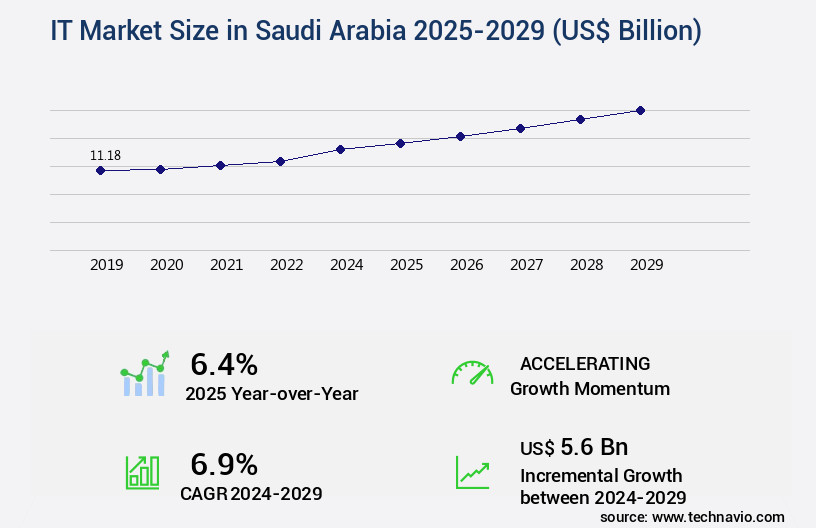
Get Key Insights on Market Forecast (PDF) Request Free Sample
How is the IT in Saudi Arabia Market Segmented and what are the key trends of market segmentation?
The it in saudi arabia industry research report provides comprehensive data (region-wise segment analysis), with forecasts and estimates in "USD billion" for the period 2025-2029, as well as historical data from 2019-2023 for the following segments.
- Component
- End-user
- Government
- IT and Telecommunication
- BFSI
- Oil and gas
- Retail and E-commerce
- Others
- Deployment Type
- On-Premises
- Cloud-Based
- Hybrid
- Geography
By Component Insights
The hardware segment is estimated to witness significant growth during the forecast period.
In Saudi Arabia, the IT market is undergoing continuous evolution as the country embraces advanced technologies for business growth. Companies are investing in robust IT infrastructure, including cybersecurity infrastructure, network security protocols, and IT infrastructure management, to ensure data security and efficiency. The digital transformation initiatives have led to the adoption of customer relationship management and compliance management systems, enabling better business intelligence and data warehousing solutions. The mobile application development sector is thriving, with an increasing number of enterprises adopting enterprise mobility for enhanced productivity. The software development lifecycle, including software testing methodologies and application performance monitoring, is being optimized through network optimization techniques and system integration services.
Furthermore, cloud computing services, including business continuity planning and risk management frameworks, are essential for business resilience. Machine learning algorithms and artificial intelligence applications are also gaining popularity, enhancing operational efficiency and driving innovation. These trends reflect the dynamic nature of the Saudi Arabian IT market, offering significant opportunities for businesses to streamline their workflows and stay competitive.
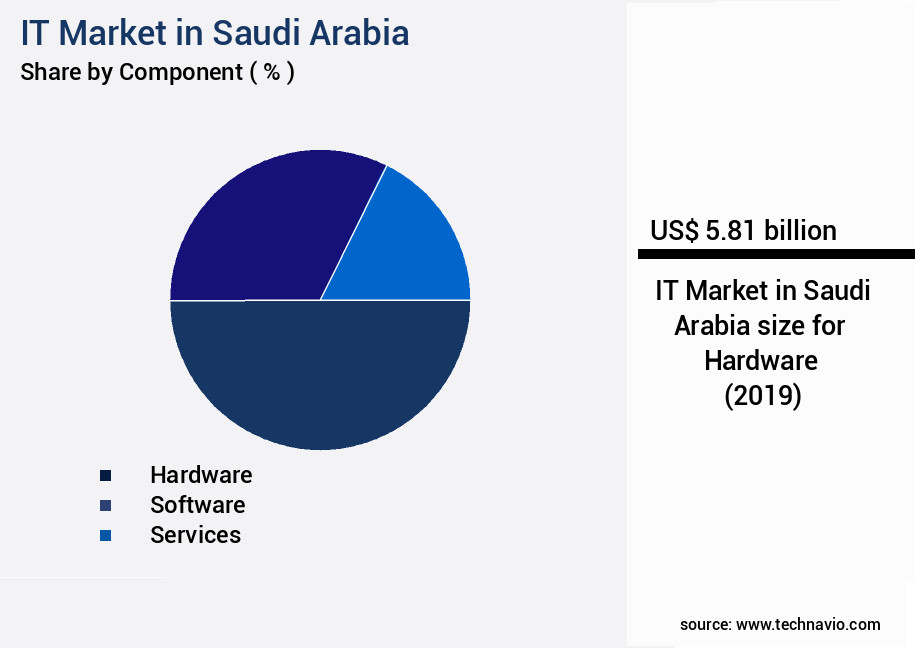
Request Free Sample
The Hardware segment was valued at USD 5.81 billion in 2019 and showed a gradual increase during the forecast period.
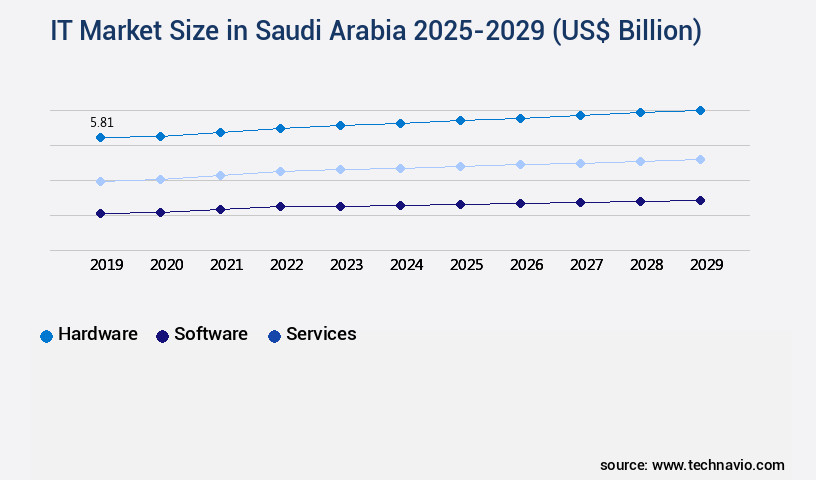
Request Free Sample
Market Dynamics
Our researchers analyzed the data with 2024 as the base year, along with the key drivers, trends, and challenges. A holistic analysis of drivers will help companies refine their marketing strategies to gain a competitive advantage.
The market is experiencing robust growth, driven by the implementation of cloud-based solutions and the design and deployment of secure networks. Companies are focusing on the development of scalable web applications and the integration of enterprise resource planning systems to streamline operations and enhance productivity. The management of IT infrastructure services and optimization of database performance are also key priorities, as businesses seek to improve IT service management and cybersecurity measures. Moreover, the adoption of agile development and DevOps practices, along with the application of machine learning models and analysis of big data analytics, is gaining traction. The development of mobile applications and implementation of digital transformation strategies are also significant trends, as Saudi Arabia's digital economy continues to expand.
Notably, over 70% of IT projects in Saudi Arabia involve the deployment of cloud migration strategies and the use of business intelligence tools. This represents a substantial shift towards digital transformation and the adoption of advanced technologies. In contrast, only a minority of players, less than 15%, dominate the high-end IT service market, leaving ample opportunities for new entrants. The Saudi Arabian market's IT landscape is characterized by a strong focus on innovation and the application of AI-powered tools. This is evident in the implementation of data warehousing and the use of AI-driven solutions for various industries, including healthcare, finance, and education.
The Kingdom's commitment to digital transformation and its strategic investment in IT infrastructure are expected to further fuel market growth in the coming years.
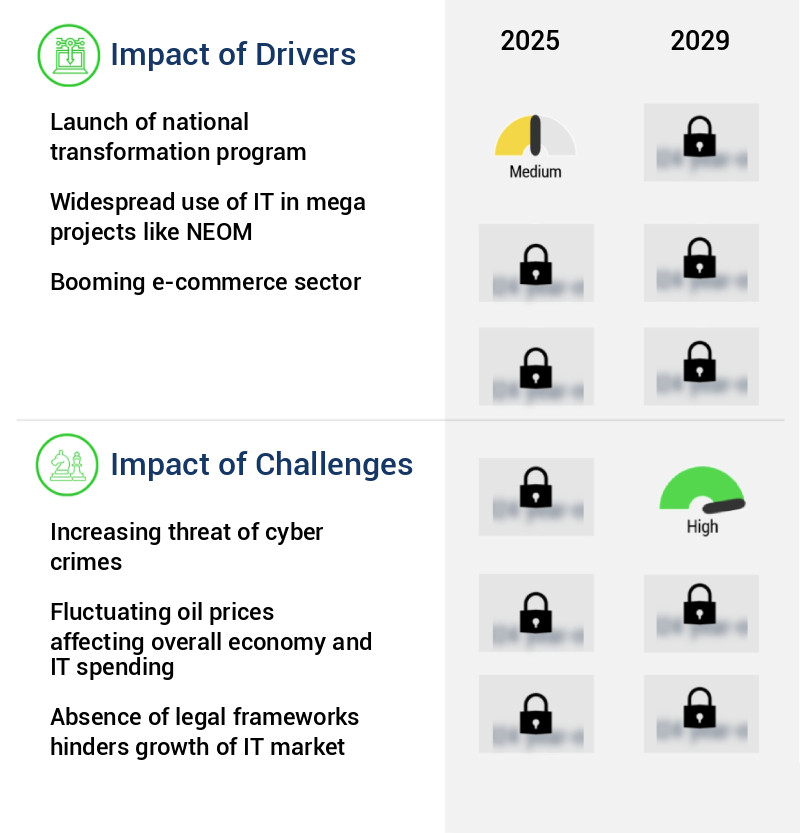
What are the key market drivers leading to the rise in the adoption of IT in Saudi Arabia Industry?
- The national transformation program's launch serves as the primary catalyst for market growth, driving significant changes and development within the industry.
- The Saudi Arabian market has witnessed significant advancements in its digital transformation journey, as outlined in the National Transformation Program (NTP), initiated in 2016. The NTP, a key component of the Vision 2030 program, focuses on economic and infrastructure development, with an emphasis on diversifying the economy and generating new employment opportunities. The IT sector's growth is a crucial element of this transformation, with plans to digitize various sectors, including manufacturing, government, healthcare, and BFSI. This shift is driven by the need to reduce reliance on oil revenues and adapt to the evolving global digital landscape. The NTP's annual report, "The Transformation Continues," reveals that 2020 saw substantial progress in this regard.
- The IT sector's expansion is not limited to the public sector alone; private enterprises are also embracing digital technologies to streamline operations and enhance customer experiences. This ongoing transformation represents a significant shift in the Saudi Arabian economy, positioning it as a key player in the global digital economy.
What are the market trends shaping the IT in Saudi Arabia Industry?
- The increasing adoption of e-governance represents a significant market trend. This shift towards digital governance solutions is a professional and efficient response to the evolving needs of modern society.
- Saudi Arabia, ranked 9th in the UN E-Government Development Index (EGDI) in 2020, is making significant strides in digital transformation through its Vision 2030 program. Over the past decade, the Saudi Arabian government has expanded its online services, including employment programs, e-learning, job searches, passports and civic affairs, traffic updates and control, commercial register issuance, and payment services. The Vision 2030 initiative plans to broaden the scope of these offerings, encompassing geographic information systems (GIS), healthcare, and education. These developments reflect a growing trend towards digitalization in the region, with e-government services increasingly becoming the norm.
- The adoption of online services not only enhances the user experience but also streamlines government operations and boosts economic growth. Saudi Arabia's commitment to digital transformation positions it as a leader in the Middle East and North Africa (MENA) region.
What challenges does the IT in Saudi Arabia Industry face during its growth?
- The escalating risk of cyber crimes poses a significant challenge to the expansion and progression of various industries.
- Enterprises in Saudi Arabia are experiencing a significant shift towards advanced technologies as the country progresses with globalization, privatization, and technological advancements. This digital transformation, coupled with the increasing adoption of cloud services and infrastructure, presents new risks for businesses in the region. Specifically, the uptake of cloud services among enterprises that have recently made the transition poses increased cybersecurity vulnerabilities. These companies often rely on the security infrastructure of their service providers, leaving their data exposed to potential cyberattacks. The consequences of such data breaches can be severe, with affected enterprises experiencing negative performance impacts and customers suffering from potential financial losses.
- Cybercriminals can quickly gain access to sensitive personal, social, and financial information, leading to significant financial repercussions. As a professional, it is crucial to acknowledge and address these risks in the context of the evolving technological landscape. The importance of robust cybersecurity measures cannot be overstated, particularly in an era marked by the widespread adoption of cloud services.
Exclusive Customer Landscape
The saudi arabia it market forecasting report includes the adoption lifecycle of the market, covering from the innovator’s stage to the laggard’s stage. It focuses on adoption rates in different regions based on penetration. Furthermore, the saudi arabia it market report also includes key purchase criteria and drivers of price sensitivity to help companies evaluate and develop their market growth analysis strategies.
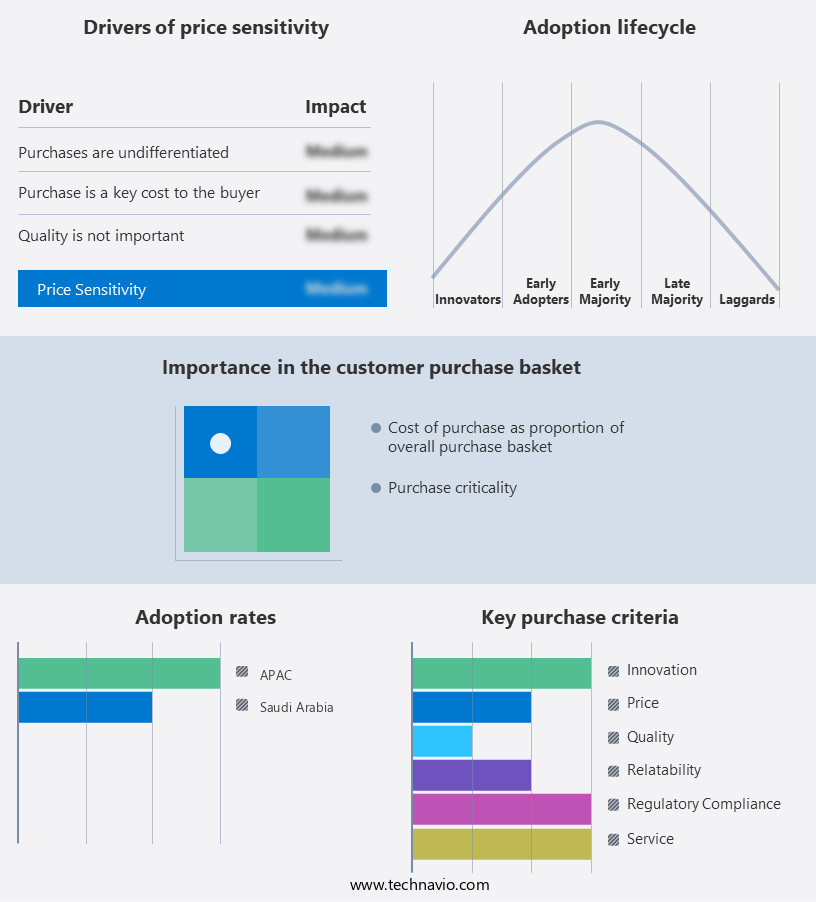
Customer Landscape of IT in Saudi Arabia Industry
Competitive Landscape & Market Insights
Companies are implementing various strategies, such as strategic alliances, saudi arabia it market forecast, partnerships, mergers and acquisitions, geographical expansion, and product/service launches, to enhance their presence in the industry.
Accenture PLC - This company specializes in providing a comprehensive range of IT solutions, encompassing computer services, cloud computing, data management, software engineering, infrastructure design, platform services, technology advancements, living systems, security, automation, and application maintenance. Their offerings cater to various industries, focusing on delivering innovative and efficient technology services.
The industry research and growth report includes detailed analyses of the competitive landscape of the market and information about key companies, including:
- Accenture PLC
- Al Moammar Information Systems Co.
- Amazon.com Inc.
- AT and T Inc.
- Cisco Systems Inc.
- Cognizant Technology Solutions Corp.
- Comprehensive Technology Co.
- DataFlow Group
- Easy World Automation LLC
- Ejada Systems Ltd.
- Google LLC
- Hewlett Packard Enterprise Co.
- Huawei Technologies Co. Ltd.
- International Business Machines Corp.
- IQVIA Holdings Inc.
- Microsoft Corp.
- NEC Corp.
- Oracle Corp.
- SAP SE
- SAS Institute Inc.
Qualitative and quantitative analysis of companies has been conducted to help clients understand the wider business environment as well as the strengths and weaknesses of key industry players. Data is qualitatively analyzed to categorize companies as pure play, category-focused, industry-focused, and diversified; it is quantitatively analyzed to categorize companies as dominant, leading, strong, tentative, and weak.
Recent Development and News in IT Market In Saudi Arabia
- In January 2024, Microsoft announced the launch of its new cloud data centers in Saudi Arabia, marking a significant expansion of its Azure services in the Middle East. This move aimed to cater to the growing demand for cloud services in the region and strengthened Microsoft's presence in the Saudi Arabian IT market (Microsoft Press Release).
- In March 2024, Saudi Aramco, the state-owned oil company, and IBM signed a strategic collaboration agreement to develop a digital transformation roadmap for the energy sector. This partnership aimed to leverage IBM's expertise in AI, cloud, and data analytics to optimize Saudi Aramco's operations and enhance its digital capabilities (IBM Press Release).
- In May 2024, STC Group, the leading telecommunications company in Saudi Arabia, completed the acquisition of a 51% stake in Mobily, a major mobile network operator. This deal consolidated STC's position as the dominant player in the Saudi Arabian telecom market and expanded its mobile customer base (STC Group Press Release).
- In January 2025, the Saudi Arabian General Investment Authority (SAGIA) announced the establishment of the Saudi Data and Artificial Intelligence Authority (SDAIA), which aimed to regulate and develop the data and AI sector in the country. This initiative marked a significant step towards creating a favorable regulatory environment for IT companies in Saudi Arabia (SAGIA Press Release).
Dive into Technavio’s robust research methodology, blending expert interviews, extensive data synthesis, and validated models for unparalleled Saudi Arabia IT Market insights. See full methodology.
|
Market Scope
|
|
Report Coverage
|
Details
|
|
Page number
|
167
|
|
Base year
|
2024
|
|
Historic period
|
2019-2023 |
|
Forecast period
|
2025-2029
|
|
Growth momentum & CAGR
|
Accelerate at a CAGR of 6.9%
|
|
Market growth 2025-2029
|
USD 5.6 billion
|
|
Market structure
|
Fragmented
|
|
YoY growth 2024-2025(%)
|
6.4
|
|
Key countries
|
Saudi Arabia
|
|
Competitive landscape
|
Leading Companies, Market Positioning of Companies, Competitive Strategies, and Industry Risks
|
Request Free Sample
Research Analyst Overview
- In the dynamic IT market of Saudi Arabia, cybersecurity infrastructure continues to be a priority as businesses increasingly adopt digital transformation initiatives. Mobile application development and network security protocols are at the forefront of this shift, with an emphasis on customer relationship management and compliance management systems. IT governance frameworks and infrastructure management are also crucial, as network optimization techniques gain traction. E-commerce platform development and software development lifecycle are essential components of the Saudi Arabian IT landscape, with database management systems and enterprise resource planning systems playing key roles. Data center infrastructure and web application development are also significant areas of investment, as businesses seek to optimize their IT environments.
- System integration services, application performance monitoring, and software testing methodologies are increasingly in demand, as businesses prioritize efficiency and reliability in their IT systems. Cloud computing services, business continuity planning, and risk management frameworks are also critical, as organizations look to mitigate risks and ensure business resilience. Machine learning algorithms, disaster recovery planning, business intelligence tools, and data warehousing solutions are also gaining popularity, as Saudi Arabian businesses leverage advanced technologies to gain insights and streamline operations. The market continues to evolve, with a focus on innovation, efficiency, and security.
What are the Key Data Covered in this Saudi Arabia IT Market Research and Growth Report?
-
What is the expected growth of the Saudi Arabia IT Market between 2025 and 2029?
-
What segmentation does the market report cover?
-
The report segmented by Component (Hardware, Software, and Services), End-user (Government, IT and Telecommunication, BFSI, Oil and gas, Retail and E-commerce, and Others), and Deployment Type (On-Premises, Cloud-Based, and Hybrid)
-
Which regions are analyzed in the report?
-
What are the key growth drivers and market challenges?
-
Who are the major players in the IT Market in Saudi Arabia?
-
Key Companies Accenture PLC, Al Moammar Information Systems Co., Amazon.com Inc., AT and T Inc., Cisco Systems Inc., Cognizant Technology Solutions Corp., Comprehensive Technology Co., DataFlow Group, Easy World Automation LLC, Ejada Systems Ltd., Google LLC, Hewlett Packard Enterprise Co., Huawei Technologies Co. Ltd., International Business Machines Corp., IQVIA Holdings Inc., Microsoft Corp., NEC Corp., Oracle Corp., SAP SE, and SAS Institute Inc.
Market Research Insights
- The market continues to exhibit dynamic growth, with significant investments in various sectors. In 2021, the spending on IT services and hardware reached an estimated USD11.5 billion, marking a 5% increase from the previous year. Notably, the IT services sector accounted for approximately 70% of the total IT expenditure. Moreover, the demand for advanced IT solutions has been on the rise, with a particular focus on data loss prevention, DevOps implementation, and security vulnerability management. In response, businesses have been prioritizing IT risk assessment, ML model deployment, and application monitoring tools to mitigate potential threats and enhance operational efficiency.
- The adoption of SaaS platforms, ERP system implementation, and IT infrastructure modernization strategies have also been prominent trends. In contrast, the spending on software quality assurance and CRM system customization saw a relatively slower growth rate, accounting for 3% and 2% of the total IT expenditure, respectively. Despite this, these areas remain essential components of digital workplace solutions and AI-powered business solutions, which are increasingly becoming the cornerstone of organizational success in Saudi Arabia.
We can help! Our analysts can customize this saudi arabia it market research report to meet your requirements.
Get in touch
1 Executive Summary
- 1.1 Market overview
- Executive Summary - Chart on Market Overview
- Executive Summary - Data Table on Market Overview
- Executive Summary - Chart on Country Market Characteristics
- Executive Summary - Chart on Market Segmentation by Component
- Executive Summary - Chart on Market Segmentation by End-user
- Executive Summary - Chart on Company Market Positioning
2 Technavio Analysis
- 2.1 Analysis of price sensitivity, lifecycle, customer purchase basket, adoption rates, and purchase criteria
- Analysis of price sensitivity, lifecycle, customer purchase basket, adoption rates, and purchase criteria
- 2.2 Criticality of inputs and Factors of differentiation
- Overview on criticality of inputs and factors of differentiation
- 2.3 Factors of disruption
- Overview on factors of disruption
- 2.4 Impact of drivers and challenges
- Impact of drivers and challenges in 2024 and 2029
3 Market Landscape
- 3.1 Market ecosystem
- Parent Market
- Data Table on - Parent Market
- 3.2 Market characteristics
- Market characteristics analysis
4 Market Sizing
- 4.1 Market definition
- Offerings of companies included in the market definition
- 4.2 Market segment analysis
- 4.4 Market outlook: Forecast for 2024-2029
- Chart on Saudi Arabia - Market size and forecast 2024-2029 ($ million)
- Data Table on Saudi Arabia - Market size and forecast 2024-2029 ($ million)
- Chart on Saudi Arabia: Year-over-year growth 2024-2029 (%)
- Data Table on Saudi Arabia: Year-over-year growth 2024-2029 (%)
5 Historic Market Size
- 5.1 IT Market in Saudi Arabia 2019 - 2023
- Historic Market Size - Data Table on IT Market in Saudi Arabia 2019 - 2023 ($ million)
- 5.2 Component segment analysis 2019 - 2023
- Historic Market Size - Component Segment 2019 - 2023 ($ million)
- 5.3 End-user segment analysis 2019 - 2023
- Historic Market Size - End-user Segment 2019 - 2023 ($ million)
6 Qualitative Analysis
- 6.1 The AI Impact on IT Market in Saudi Arabia
7 Five Forces Analysis
- 7.1 Five forces summary
- Five forces analysis - Comparison between 2024 and 2029
- 7.2 Bargaining power of buyers
- Bargaining power of buyers - Impact of key factors 2024 and 2029
- 7.3 Bargaining power of suppliers
- Bargaining power of suppliers - Impact of key factors in 2024 and 2029
- 7.4 Threat of new entrants
- Threat of new entrants - Impact of key factors in 2024 and 2029
- 7.5 Threat of substitutes
- Threat of substitutes - Impact of key factors in 2024 and 2029
- 7.6 Threat of rivalry
- Threat of rivalry - Impact of key factors in 2024 and 2029
- 7.7 Market condition
- Chart on Market condition - Five forces 2024 and 2029
8 Market Segmentation by Component
- 8.1 Market segments
- Chart on Component - Market share (2024-2029) (%)
- Data Table on Component - Market share (2024-2029) (%)
- 8.2 Comparison by Component
- Chart on Comparison by Component
- Data Table on Comparison by Component
- 8.3 Hardware - Market size and forecast (2024-2029)
- Chart on Hardware - Market size and forecast (2024-2029) ($ million)
- Data Table on Hardware - Market size and forecast (2024-2029) ($ million)
- Chart on Hardware - Year-over-year growth (2024-2029) (%)
- Data Table on Hardware - Year-over-year growth (2024-2029) (%)
- 8.4 Software - Market size and forecast (2024-2029)
- Chart on Software - Market size and forecast (2024-2029) ($ million)
- Data Table on Software - Market size and forecast (2024-2029) ($ million)
- Chart on Software - Year-over-year growth (2024-2029) (%)
- Data Table on Software - Year-over-year growth (2024-2029) (%)
- 8.5 Services - Market size and forecast (2024-2029)
- Chart on Services - Market size and forecast (2024-2029) ($ million)
- Data Table on Services - Market size and forecast (2024-2029) ($ million)
- Chart on Services - Year-over-year growth (2024-2029) (%)
- Data Table on Services - Year-over-year growth (2024-2029) (%)
- 8.6 Market opportunity by Component
- Market opportunity by Component ($ million)
- Data Table on Market opportunity by Component ($ million)
9 Market Segmentation by End-user
- 9.1 Market segments
- Chart on End-user - Market share (2024-2029) (%)
- Data Table on End-user - Market share (2024-2029) (%)
- 9.2 Comparison by End-user
- Chart on Comparison by End-user
- Data Table on Comparison by End-user
- 9.3 Government - Market size and forecast (2024-2029)
- Chart on Government - Market size and forecast (2024-2029) ($ million)
- Data Table on Government - Market size and forecast (2024-2029) ($ million)
- Chart on Government - Year-over-year growth (2024-2029) (%)
- Data Table on Government - Year-over-year growth (2024-2029) (%)
- 9.4 IT and Telecommunication - Market size and forecast (2024-2029)
- Chart on IT and Telecommunication - Market size and forecast (2024-2029) ($ million)
- Data Table on IT and Telecommunication - Market size and forecast (2024-2029) ($ million)
- Chart on IT and Telecommunication - Year-over-year growth (2024-2029) (%)
- Data Table on IT and Telecommunication - Year-over-year growth (2024-2029) (%)
- 9.5 BFSI - Market size and forecast (2024-2029)
- Chart on BFSI - Market size and forecast (2024-2029) ($ million)
- Data Table on BFSI - Market size and forecast (2024-2029) ($ million)
- Chart on BFSI - Year-over-year growth (2024-2029) (%)
- Data Table on BFSI - Year-over-year growth (2024-2029) (%)
- 9.6 Oil and gas - Market size and forecast (2024-2029)
- Chart on Oil and gas - Market size and forecast (2024-2029) ($ million)
- Data Table on Oil and gas - Market size and forecast (2024-2029) ($ million)
- Chart on Oil and gas - Year-over-year growth (2024-2029) (%)
- Data Table on Oil and gas - Year-over-year growth (2024-2029) (%)
- 9.7 Retail and E-commerce - Market size and forecast (2024-2029)
- Chart on Retail and E-commerce - Market size and forecast (2024-2029) ($ million)
- Data Table on Retail and E-commerce - Market size and forecast (2024-2029) ($ million)
- Chart on Retail and E-commerce - Year-over-year growth (2024-2029) (%)
- Data Table on Retail and E-commerce - Year-over-year growth (2024-2029) (%)
- 9.8 Others - Market size and forecast (2024-2029)
- Chart on Others - Market size and forecast (2024-2029) ($ million)
- Data Table on Others - Market size and forecast (2024-2029) ($ million)
- Chart on Others - Year-over-year growth (2024-2029) (%)
- Data Table on Others - Year-over-year growth (2024-2029) (%)
- 9.9 Market opportunity by End-user
- Market opportunity by End-user ($ million)
- Data Table on Market opportunity by End-user ($ million)
10 Market Segmentation by Deployment Type
- 10.1 Market segments
- Chart on Deployment Type - Market share (2024-2029) (%)
- Data Table on Deployment Type - Market share (2024-2029) (%)
- 10.2 Comparison by Deployment Type
- Chart on Comparison by Deployment Type
- Data Table on Comparison by Deployment Type
- 10.3 On-Premises - Market size and forecast (2024-2029)
- Chart on On-Premises - Market size and forecast (2024-2029) ($ million)
- Data Table on On-Premises - Market size and forecast (2024-2029) ($ million)
- Chart on On-Premises - Year-over-year growth (2024-2029) (%)
- Data Table on On-Premises - Year-over-year growth (2024-2029) (%)
- 10.4 Cloud-Based - Market size and forecast (2024-2029)
- Chart on Cloud-Based - Market size and forecast (2024-2029) ($ million)
- Data Table on Cloud-Based - Market size and forecast (2024-2029) ($ million)
- Chart on Cloud-Based - Year-over-year growth (2024-2029) (%)
- Data Table on Cloud-Based - Year-over-year growth (2024-2029) (%)
- 10.5 Hybrid - Market size and forecast (2024-2029)
- Chart on Hybrid - Market size and forecast (2024-2029) ($ million)
- Data Table on Hybrid - Market size and forecast (2024-2029) ($ million)
- Chart on Hybrid - Year-over-year growth (2024-2029) (%)
- Data Table on Hybrid - Year-over-year growth (2024-2029) (%)
- 10.6 Market opportunity by Deployment Type
- Market opportunity by Deployment Type ($ million)
- Data Table on Market opportunity by Deployment Type ($ million)
11 Customer Landscape
- 11.1 Customer landscape overview
- Analysis of price sensitivity, lifecycle, customer purchase basket, adoption rates, and purchase criteria
12 Drivers, Challenges, and Opportunity/Restraints
- 12.3 Impact of drivers and challenges
- Impact of drivers and challenges in 2024 and 2029
- 12.4 Market opportunities/restraints
13 Competitive Landscape
- 13.2 Competitive Landscape
- Overview on criticality of inputs and factors of differentiation
- 13.3 Landscape disruption
- Overview on factors of disruption
- 13.4 Industry risks
- Impact of key risks on business
14 Competitive Analysis
- 14.2 Company ranking index
- 14.3 Market positioning of companies
- Matrix on companies position and classification
- 14.4 Accenture PLC
- Accenture PLC - Overview
- Accenture PLC - Business segments
- Accenture PLC - Key news
- Accenture PLC - Key offerings
- Accenture PLC - Segment focus
- SWOT
- 14.5 Al Moammar Information Systems Co.
- Al Moammar Information Systems Co. - Overview
- Al Moammar Information Systems Co. - Product / Service
- Al Moammar Information Systems Co. - Key offerings
- SWOT
- 14.6 Amazon.com Inc.
- Amazon.com Inc. - Overview
- Amazon.com Inc. - Business segments
- Amazon.com Inc. - Key news
- Amazon.com Inc. - Key offerings
- Amazon.com Inc. - Segment focus
- SWOT
- 14.7 Cisco Systems Inc.
- Cisco Systems Inc. - Overview
- Cisco Systems Inc. - Business segments
- Cisco Systems Inc. - Key news
- Cisco Systems Inc. - Key offerings
- Cisco Systems Inc. - Segment focus
- SWOT
- 14.8 Cognizant Technology Solutions Corp.
- Cognizant Technology Solutions Corp. - Overview
- Cognizant Technology Solutions Corp. - Business segments
- Cognizant Technology Solutions Corp. - Key news
- Cognizant Technology Solutions Corp. - Key offerings
- Cognizant Technology Solutions Corp. - Segment focus
- SWOT
- 14.9 Comprehensive Technology Co.
- Comprehensive Technology Co. - Overview
- Comprehensive Technology Co. - Product / Service
- Comprehensive Technology Co. - Key offerings
- SWOT
- 14.10 Easy World Automation LLC
- Easy World Automation LLC - Overview
- Easy World Automation LLC - Product / Service
- Easy World Automation LLC - Key offerings
- SWOT
- 14.11 Ejada Systems Ltd.
- Ejada Systems Ltd. - Overview
- Ejada Systems Ltd. - Product / Service
- Ejada Systems Ltd. - Key offerings
- SWOT
- 14.12 Google LLC
- Google LLC - Overview
- Google LLC - Product / Service
- Google LLC - Key offerings
- SWOT
- 14.13 Hewlett Packard Enterprise Co.
- Hewlett Packard Enterprise Co. - Overview
- Hewlett Packard Enterprise Co. - Business segments
- Hewlett Packard Enterprise Co. - Key news
- Hewlett Packard Enterprise Co. - Key offerings
- Hewlett Packard Enterprise Co. - Segment focus
- SWOT
- 14.14 Huawei Technologies Co. Ltd.
- Huawei Technologies Co. Ltd. - Overview
- Huawei Technologies Co. Ltd. - Product / Service
- Huawei Technologies Co. Ltd. - Key news
- Huawei Technologies Co. Ltd. - Key offerings
- SWOT
- 14.15 International Business Machines Corp.
- International Business Machines Corp. - Overview
- International Business Machines Corp. - Business segments
- International Business Machines Corp. - Key news
- International Business Machines Corp. - Key offerings
- International Business Machines Corp. - Segment focus
- SWOT
- 14.16 Microsoft Corp.
- Microsoft Corp. - Overview
- Microsoft Corp. - Business segments
- Microsoft Corp. - Key news
- Microsoft Corp. - Key offerings
- Microsoft Corp. - Segment focus
- SWOT
- 14.17 Oracle Corp.
- Oracle Corp. - Overview
- Oracle Corp. - Business segments
- Oracle Corp. - Key news
- Oracle Corp. - Key offerings
- Oracle Corp. - Segment focus
- SWOT
- 14.18 SAP SE
- SAP SE - Overview
- SAP SE - Business segments
- SAP SE - Key news
- SAP SE - Key offerings
- SAP SE - Segment focus
- SWOT
15 Appendix
- 15.2 Inclusions and exclusions checklist
- Inclusions checklist
- Exclusions checklist
- 15.3 Currency conversion rates for US$
- Currency conversion rates for US$
- 15.4 Research methodology
- 15.7 Validation techniques employed for market sizing
- Validation techniques employed for market sizing
- 15.9 360 degree market analysis
- 360 degree market analysis
- 15.10 List of abbreviations







![]() Get the report (PDF) sent to your email within minutes.
Get the report (PDF) sent to your email within minutes.
Complimentary full Excel data with your report purchase.